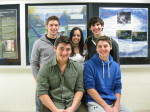Five Intel Science Semifinalists Selected From Byram Hills

Five Byram Hills High School students won semifinalist honors last week in the prestigious national Intel Science Talent Search, the most of any school district in Westchester County this year.
The students tackled a variety of projects that ranged from building an automatic transport ventilator to gaining a better understanding of the effects of alcohol. The five seniors all participate in the district’s highly regarded science research program, where students work with teachers on independent research.
“These students are a testimony to our school, district and community,” said science teacher Stephanie Greenwald. “We’ve worked together to foster a high level of thinking and we encourage our students to follow their passions.”
The Byram Hills students are among 300 semifinalists selected from more than 1,700 entrants
representing 467 high schools across the nation. Each semifinalist in the competition, considered by many as the top science contest for high school students, receives a $1,000 award. Schools also receive $1,000 for each semifinalist chosen.
This year’s winners are Rose Arditi, Zachary Blum, Christopher DiCapua, Gregory Fishberger and Jonathan Bricker.
Arditi’s project used mice to study how the brain remembers fear and to learn about brain resilience–a project that could have applications for people with Post Traumatic Stress Syndrome.
Blum measured age-related memory decline, learning more about how memory loss could be predicted by the decline in executive functioning in individuals.
DiCapua, whose older brother was also an Intel semifinalist, created, built and patented a novel automatic transport ventilator that could be used by volunteer bystanders on people needing CPR.
Fishberger looked at tumor-suppressing genes and studied about the mechanism for turning the genes on and off.
Bricker’s work, which involved inserting neural receptors into frogs’ eggs, was geared to gaining a better understanding of how alcohol affects the nerves.
The five students all participate in the Dr. Robert Pavlica Authentic Science Research Program at Byram Hills. Each year, about 100 of the school’s students work independently each school day under faculty supervision and learn how to conduct and present research. The program is directed by science teacher David Keith and also includes Greenwald and fellow teacher Kenneth Kaplan.
Of the 300 semifinalists, 40 are chosen to attend the Intel Science Talent Institute in Washington, D.C. in March when there will be further judging and $630,000 will be awarded.

Martin has more than 30 years experience covering local news in Westchester and Putnam counties, including a frequent focus on zoning and planning issues. He has been editor-in-chief of The Examiner since its inception in 2007. Read more from Martin’s editor-author bio here. Read Martin’s archived work here: https://www.theexaminernews.com/author/martin-wilbur2007/
